Live on the homepage now!
Reader Supported News
U.S. officials warn that tensions over Ukraine could trigger a once unthinkable conflict pitting Russia against NATO.
On Tuesday, a new U.S. intelligence assessment concluded that Russia will pursue its interests in “competitive and sometimes confrontational and provocative ways, including pressing to dominate Ukraine and other countries in its ‘near-abroad.’ ” In testimony on the Hill, William Burns, the C.I.A. director and a former Ambassador to Russia, was pressed about Vladimir Putin’s intent. “He’s not going to stop at Ukraine, correct?” asked Representative Jackie Speier, of California. Burns replied, “That’s what makes it more important than ever to demonstrate that he’s not going to succeed in Ukraine.” The stakes, Burns acknowledged, are bigger. “This is one of those pivotal points where we and all of our allies and partners need to act.”
Since Russia’s invasion, the besieged Ukrainian President, Volodymyr Zelensky, has repeatedly warned the West about the danger that Putin would target other European nations. “Everyone thinks that we are far away from America or Canada. No, we are in this zone of freedom,” Zelensky said in a television interview, on Monday. “And, when the limits of rights and freedoms are being violated and stepped on, then you have to protect us. Because we will come first. You will come second. Because, the more this beast will eat, he wants more, more, and more.”
The U.S., however, pushed back this week on key military requests from Ukraine, for fear of Russia’s reaction. Putin’s reckless offensive has forced the U.S. to adopt awkward policy positions. On March 5th, Zelensky made an impassioned appeal to members of the House and Senate for more military aid, notably help in obtaining Soviet-era warplanes that Ukrainian pilots are trained to fly and that could balance Russia’s air superiority. On Wednesday, the Pentagon rejected an offer from Poland to turn over twenty-eight MIG-29 fighter jets to U.S. custody—flying them to a base in Germany—for transfer to Ukraine. U.S. intelligence officials assessed that an American role in a transfer “may be mistaken as escalatory and could result in significant Russian reaction that might increase the prospects of a military escalation with NATO,” the Pentagon spokesman, John Kirby, told reporters. U.S. involvement was deemed to be “high risk.” The majority of Ukraine’s warplanes are still intact, a senior Defense Department official added, while acknowledging that Russia’s surface-to-air missiles now have an “umbrella” that covers virtually all of Ukraine.
The Administration cited the same fears about Zelensky’s request for help from NATO in establishing a no-fly zone over part of Ukraine to protect civilians. “We also have to see to it that this war does not expand,” Blinken said on Wednesday, at a joint press conference with his British counterpart. “Our goal is to end the war, not to expand it, including potentially expand it to NATO territory.” Otherwise, he warned, “it’s going to turn even deadlier, involve more people, and I think potentially even make things harder to resolve in Ukraine itself.”
On Thursday, Avril Haines, the director of National Intelligence, acknowledged that the U.S. is now in a uniquely challenging position. “We are obviously providing enormous amounts of support to the Ukrainians, as we should and need to do,” she told the Senate Intelligence Committee. “But at the same time trying not to escalate the conflict into a full-on NATO or U.S. war with Russia. And that’s a challenging space to manage.”
Yet, at each of his four stops in NATO countries near Russia, Blinken heard dire predictions about the broader Russian threat beyond Ukraine—and the need for the U.S. to do more. In Riga, on Monday, the Latvian Foreign Minister, Edgars Rinkēvičs, lamented to Blinken, “We have no illusions about Putin’s Russia anymore.” In Vilnius, the Lithuanian President, Gitanas Nauseda, turned to Blinken and said, “Deterrence is no longer enough. We need more defense here, because otherwise it will be too late here, Mr. Secretary. Putin will not stop in Ukraine; he will not stop.” And in Tallinn, on Tuesday, the Estonian Prime Minister, Kaja Kallas, said that NATO countries “need to adapt to the new reality” of a “very aggressive Russia” and permanently strengthen their defenses in the air, on land, and at sea. Pressed on what specifically countries on Russia’s borders needed, she replied, “Everything.”
Eastern European countries—notably those once allied with, or part of, the former Soviet Union’s empire—have long warned of the potential for Russian aggression. “We, the Poles, are already tired of reminding everyone: ‘We told ya so,’ ” Marek Magierowski, Poland’s Ambassador to the U.S., told me in an interview this week. He cited the forewarning by the late Polish President Lech Kaczynski during the Russian invasion of Georgia, in 2008. “Today Georgia, tomorrow Ukraine, the day after tomorrow—the Baltic states and later, perhaps, time will come for my country, Poland,” Kaczynski had said.
Magierowski added, “We have never had any doubts whatsoever about Vladimir Putin’s neo-imperial ambitions.” Putin has been waiting for this “window of opportunity” for years, he said. “He convinced himself that the West is weak, divided, wallowing in a decadent mood. He thought the free world wouldn’t care about Ukraine’s fate, as it didn’t care about Czechoslovakia’s in 1938,” when Europe tolerated Nazi Germany’s annexation of the Sudetenland. Putin, he told me, is similarly “emboldened” because the West was “tragically lenient” and “outrageously complacent” after Russia murdered the defector Alexander Litvinenko, in 2006; invaded and annexed Crimea, in 2014; helped destroy the Syrian city of Aleppo, in 2016; reportedly used chemical weapons to poison the former spy Sergei Skripal and his daughter, in 2018; and poisoned the opposition leader Alexey Navalny, in 2020. Over the past three decades, Eastern Europeans have often encountered skepticism of their view of Putin as the U.S. and Western Europeans, notably the former German Chancellor Angela Merkel, advocated dealing pragmatically with Russia.
During his European trip, Blinken repeatedly promised that NATO, this time, would prevent further Russian expansion. “We will defend every inch of NATO territory with the full force of our collective power,” he vowed, in Estonia. But U.S. experts worry, too, about an unintended incident triggering a wider war, like the spark that ignited the First World War, a conflict that dragged on for four years and killed tens of millions. Russia’s invasion of Ukraine “could easily escalate into a larger conflict stretching from the Baltic to the Black Sea and further west into Europe,” Thomas E. Graham, a fellow at the Council on Foreign Relations, warned in a new report issued on Tuesday. It might not matter what the U.S. does, he wrote. Crippling sanctions “could provoke Putin to lash out with greater violence,” Graham cautioned. But, if NATO appeared restrained, Moscow could be “tempted to press militarily even further into Europe” to enlarge its sphere of influence. The rippling impact of broader Russian aggression would stress “the geopolitical, economic, and institutional foundations” of the international order created after the Second World War, Graham wrote.
Given the Russian leader’s history, Angela Stent, a former National Intelligence officer and the author of “Putin’s World: Russia Against the West and with the Rest,” is worried about a miscalculation. “The concern we have to have immediately is that the war in Ukraine doesn’t inadvertently spread to Poland or Romania by some unforeseen clash, which would then have to involve NATO in a war with Russia,” she told me. Stent also worries about Putin’s intentions short of war. “You can use nonmilitary means to disrupt societies. And he’s already been doing that for the past couple of decades.” As the Russian leader grows increasingly cornered, she added, he will seek to exploit popular sentiment in countries like Serbia, where a pro-Russia march to support the war was held last week. The new U.S. intelligence assessment warns that Russia will employ “an array of tools” to undermine the interests of the U.S. and its NATO allies. “We expect Moscow to insert itself into crises” whenever it sees an opportunity, it concludes.
On Wednesday, the Biden Administration issued a forceful denial after Russia’s bizarre claim that the U.S. and Ukraine were developing chemical and biological weapons. The State Department spokesperson, Ned Price, said that Moscow has a long track record of accusing the U.S. of the very crimes that Russia is perpetrating. These tactics are “an obvious ploy” by Russia to try to justify “further premeditated, unprovoked, and unjustified attacks,” he said.
Russia, as the aggressor, still has the upper hand. But, for the U.S. and its allies, the one positive sign is that the performance of the Ukrainian military has exceeded expectations. Russian forces have fallen far short of Putin’s goal of a swift seizure of Kyiv and the ouster of Zelensky’s government. The first two weeks have, instead, been grinding for Moscow. U.S. intelligence estimates that between two thousand and four thousand troops fighting for Russia—not all of them Russian—have died in the first two weeks. The bravery of Ukrainians, so far, has prevented the worst-case scenario.
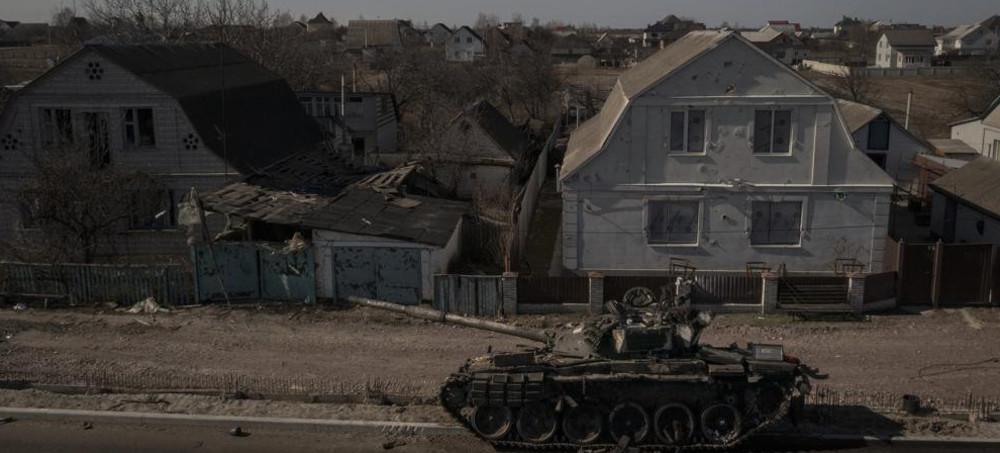 A destroyed tank is seen after battles between Ukrainian and Russian forces on a main road near Brovary, north of Kyiv, Ukraine, Thursday, March 10, 2022. (photo: Felipe Dana/AP)
A destroyed tank is seen after battles between Ukrainian and Russian forces on a main road near Brovary, north of Kyiv, Ukraine, Thursday, March 10, 2022. (photo: Felipe Dana/AP)
International condemnation escalated over an airstrike in Mariupol a day earlier that killed three people at a maternity hospital. Western and Ukrainian officials called the attack a war crime. Ukrainian President Volodymyr Zelenskyy said the Russian refusal to permit evacuations from the port city amounted to “outright terror.”
As the West seeks new ways to punish Moscow, U.S. President Joe Biden planned to announce Friday that the United States, the European Union and the Group of Seven leading industrialized nations would move to revoke Russia's “most favored nation” trade status, according to a source familiar with the matter who spoke on the condition of anonymity to preview the announcement. The loss of the trade status would allow tariffs to be imposed on Russian imports and increase the isolation of the Russian economy.
Meanwhile, the highest-level talks held since the invasion began two weeks ago yielded no progress, the number of refugees fleeing the country topped 2.3 million, and Kyiv braced for an onslaught, its mayor boasting that the capital had become practically a fortress protected by armed civilians.
Satellite imagery from Maxar Technologies showed that 40-mile (64-kilometer) convoy of vehicles, tanks and artillery has broken up and been redeployed, the company said. Armored units were seen in towns near the Antonov Airport north of the city. Some of the vehicles have moved into forests, Maxar reported, with towed howitzers nearby in position to open fire.
The convoy had massed outside the city early last week, but its advance appeared to have stalled amid reports of food and fuel shortages. U.S. officials said Ukrainian troops also targeted the convoy with anti-tank missiles.
A U.S. defense official speaking on condition of anonymity said some vehicles were seen moving off the road into the tree line in recent days, but the official could not confirm whether the convoy had dispersed.
In Mariupol, a southern seaport of 430,000, the situation was increasingly dire as civilians trapped inside the city scrounged for food and fuel. More than 1,300 people have died in the 10-day siege of the frigid city, said Deputy Prime Minister Iryna Vereshchuk.
Residents have no heat or phone service, and many have no electricity. Nighttime temperatures are regularly below freezing, and daytime ones normally hover just above it. Bodies are being buried in mass graves. The streets are littered with burned-out cars, broken glass and splintered trees.
“They have a clear order to hold Mariupol hostage, to mock it, to constantly bomb and shell it,” Zelenskyy said in his nightly video address to the nation. He said the Russians began a tank attack right where there was supposed to be a humanitarian corridor.
On Thursday, firefighters tried to free a boy trapped in the rubble. One grasped the boy's hand. His eyes blinked, but he was otherwise still. It was not clear if he survived. Nearby, at a mangled truck, a woman wrapped in a blue blanket shuddered at the sound of an explosion.
Grocery stores and pharmacies were emptied days ago by people breaking in to get supplies, according to a local official with the Red Cross, Sacha Volkov. A black market is operating for vegetables, meat is unavailable, and people are stealing gasoline from cars, Volkov said.
Places protected from bombings are hard to find, with basements reserved for women and children, he said. Residents, Volkov said, are turning on one another: “People started to attack each other for food.”
An exhausted-looking Aleksander Ivanov pulled a cart loaded with bags down an empty street flanked by damaged buildings.
“I don’t have a home anymore. That’s why I’m moving,” he said. “It doesn’t exist anymore. It was hit, by a mortar.”
Repeated attempts to send in food and medicine and evacuate civilians have been thwarted by Russian shelling, Ukrainian authorities said.
“They want to destroy the people of Mariupol. They want to make them starve,” Vereshchuk said. “It’s a war crime.”
All told, some 100,000 people have been evacuated during the past two days from seven cities under Russian blockade in the north and center of the country, including the Kyiv suburbs, Zelenskyy said.
Zelenskyy told Russian leaders that the invasion will backfire on them as their economy is strangled. Western sanctions have already dealt a severe blow, causing the ruble to plunge, foreign businesses to flee and prices to rise sharply.
“You will definitely be prosecuted for complicity in war crimes,” Zelenskyy said in a video address. "And then, it will definitely happen, you will be hated by Russian citizens — everyone whom you have been deceiving constantly, daily, for many years in a row, when they feel the consequences of your lies in their wallets, in their shrinking possibilities, in the stolen future of Russian children.”
Russian President Vladimir Putin dismissed such talk, saying the country has endured sanctions before.
″We will overcome them," he said at a televised meeting of government officials. He did, however, acknowledge the sanctions create “certain challenges.”
In addition to those who have fled the country, millions have been driven from their homes inside Ukraine. Kyiv Mayor Vitali Klitschko said about 2 million people, half the population of the metropolitan area, have left the capital.
“Every street, every house … is being fortified," he said. "Even people who in their lives never intended to change their clothes, now they are in uniform with machine guns in their hands.”
On Thursday, a 14-year-old girl named Katya was recovering at the Brovary Central District Hospital on the outskirts of Kyiv after her family was ambushed as they tried to flee the area. She was shot in the hand when their car was raked with gunfire from a roadside forest, said her mother, who identified herself only as Nina.
The girl’s father, who drove frantically from the ambush on blown-out tires, underwent surgery. His wife said he had been shot in the head and had two fingers blown off.
Western officials said Russian forces have made little progress on the ground in recent days and are seeing heavier losses and stiffer Ukrainian resistance than Moscow apparently anticipated. But Putin’s forces have used air power and artillery to pummel Ukraine's cities.
Early in the day, the Mariupol city council posted a video showing a convoy it said was bringing in food and medicine. But as night fell, it was unclear if those buses had reached the city.
A child was among those killed in the hospital airstrike Wednesday. Seventeen people were also wounded, including women waiting to give birth, doctors, and children buried in the rubble. Images of the attack, with pregnant women covered in dust and blood, dominated news reports in many countries.
French President Emmanuel Macron called the attack “a shameful and immoral act of war.” Britain’s Armed Forces minister, James Heappey, said that whether the hospital was hit by indiscriminate fire or deliberately targeted, “it is a war crime.”
U.S. Vice President Kamala Harris, on a visit to Ukraine's neighbor Poland, backed calls for an international war-crimes investigation into the invasion, saying, “The eyes of the world are on this war and what Russia has done in terms of this aggression and these atrocities.”
Russian Foreign Minister Sergey Lavrov dismissed concerns about civilian casualties as “pathetic shrieks” from Russia’s enemies, and denied Ukraine had even been invaded.
Lavrov and his Ukrainian counterpart, Dmytro Kuleba, held talks in a Turkish resort in their first meeting since the invasion.
The two sides discussed a 24-hour cease-fire but made no progress, Kuleba said. He said Russia still wanted Ukraine to surrender but insisted that will not happen.
Lavrov said Russia is ready for more negotiations, but he showed no sign of softening Moscow’s demands.
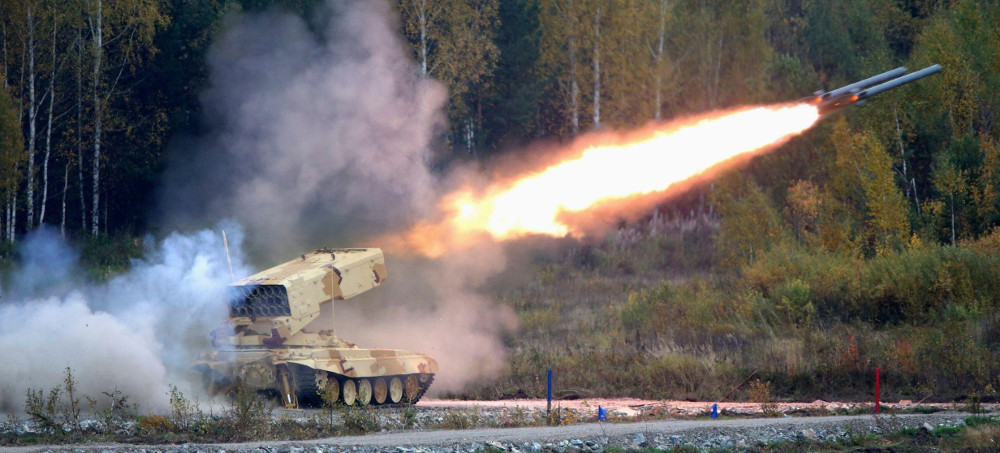 Moscow 'confirmed the use of the TOS-1A weapon system in Ukraine,' the U.K.'s Ministry of Defense tweeted. (photo: Getty)
Moscow 'confirmed the use of the TOS-1A weapon system in Ukraine,' the U.K.'s Ministry of Defense tweeted. (photo: Getty)
Moscow "confirmed the use of the TOS-1A weapon system in Ukraine," the U.K.'s Ministry of Defense tweeted.
The statement was accompanied by a video of the Soviet-era weapon, which launches rockets from atop a tank body that suck in surrounding oxygen, creating higher temperatures and more damaging explosions that last longer than conventional blasts.
"The impact of the TOS-1A is devastating," the U.K.'s Ministry of Defense said in the video. "It can destroy infrastructure and cause significant damage to internal organs and flash burns, resulting in death to those exposed."
The U.S. military, however, has still seen "no indications" that thermobaric weapons have been used, Pentagon press secretary John Kirby told reporters later Wednesday.
Under international laws of armed conflict, thermobaric weapons are not illegal but can't be used against military targets if their launch could also harm civilians.
Footage from the Kremlin incursion, which is now at the two-week mark, has shown TOS-1A weapons deployed to Ukraine.
"We have seen videos of Russian forces moving exceptionally lethal weaponry into Ukraine which has no place on the battlefield," the U.S. envoy to the United Nations (U.N.) Linda Thomas-Greenfield, told the U.N. General Assembly last week.
Ukraine's Ambassador to the U.S., Oksana Markarova, made similar allegations to American lawmakers.
Russia's confirmation comes after U.S. officials and lawmakers warned that Moscow is escalating its violence in Ukraine, with hundreds of civilians, including children, killed in attacks.
Russia has been criticized for targeting civilian infrastructure, including communication networks, schools and hospitals.
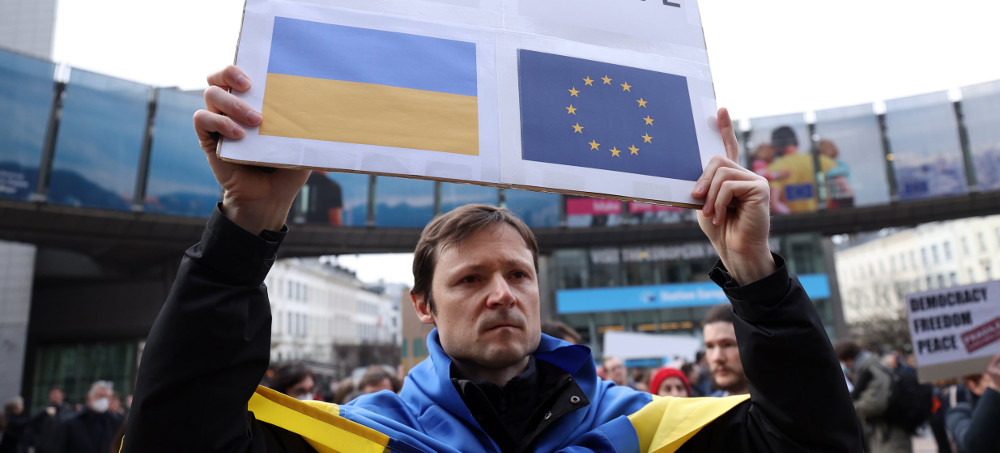 Ukrainian president Volodymyr Zelensky has signed an application for his country to join the European Union. (photo: AP)
Ukrainian president Volodymyr Zelensky has signed an application for his country to join the European Union. (photo: AP)
Analysis: Zelenskiy once played a TV president turned down by Merkel, but how real are his country’s prospects?
“Oh fuck,” Zelenskiy says, as Beethoven’s Ode to Joy, the EU anthem, soars into life.
It is an old clip from Zelenskiy’s acting days, when he played Ukraine’s accidental president in the hit TV show Servant of the People. It was filmed several years before Russia’s all-out attack began, before bombs fell on a maternity hospital in besieged Mariupol, before a six-year-old girl died of dehydration under the rubble of her destroyed home, according to Ukrainian officials.
The clip went viral last week, because the topic of Ukraine’s EU membership is no longer a joke in a TV show but an urgent question.
The real President Zelenskiy filed Ukraine’s application for EU membership five days into Russia’s invasion, calling for “immediate accession via a new special procedure”.
As EU leaders gathered on Thursday to discuss that bid in the historically charged setting of Versailles, Ukraine’s foreign minister, Dmytro Kuleba, urged them to make it happen. “Ukraine is a strong force for good, a brave and intelligent nation which will contribute greatly to the political, economic, cultural and social strength of the EU after this war is over,” he wrote in the Financial Times. “It will be a matter of prestige, as well as strength, for the EU to have a member like us.”
While the EU has surprised observers with its unity and readiness to cast aside old doctrines to stand against Russia’s aggression, EU membership for Ukraine appears to be a step too far.
This is not for lack of support. The EU remembers the 2014 Euromaidan revolution, when peaceful protesters lost their lives to defend Ukraine’s right to choose a European future. Eight member states, all in central and eastern Europe, have called on the EU to “immediately” grant Ukraine EU candidate status and open the process of negotiations.
But supporters know it is an uphill battle. “They have even more values than many of us, but, practically, it will be very challenging,” said one senior diplomat. Old member states, including France, Germany, the Netherlands and Denmark, do not want Ukraine to get a shortcut to EU membership.
Officials point out that Ukraine needs to be able to absorb the 80,000-page EU rule book, the acquis communautaire, encompassing everything from air pollution to the monitoring of zoonoses (infectious diseases from animals). Underpinning this mountain of technical regulations is a sound public administration, an independent judiciary and a market economy. “Let’s be fair, Ukraine is nowhere near that point, especially because of what Mr Putin has done,” a senior EU diplomat said, adding that even before the war, Ukraine was “not moving in the right direction” on the Copenhagen criteria – EU standards on democracy, the rule of law and the economy.
“We want to say yes to Ukraine as much as possible: moral support, show sympathy with the Ukrainian people, make clear they are part of our community of values,” the diplomat added, while suggesting that Ukraine could go well beyond its existing trade and association agreement, via participation in the EU Erasmus student exchange programme or ministerial attendance at EU meetings.
“I think Ukrainians are making [membership] too big an issue and by listening to others who are making this into an easy political decision,” the person said.
The EU diplomat ruled out the suggestion that the EU’s reluctance stemmed from concern over antagonising the Kremlin, but supporters of Ukraine’s EU membership fear this is the real reason. Like Nato, the EU also has its own mutual defence clause, where an attack on one is an attack on all. “There are governments [in old member states] who think we can negotiate with Putin and exchange Ukraine’s European aspirations for peace,” another senior diplomat told the Guardian. “And I just think this is an illusion.”
Long before Ukraine’s membership bid, the EU’s old member states were wary of EU enlargement and burned by democratic backsliding in Poland and Hungary, or lingering corruption in Bulgaria and Romania. “Enlargement changes to a certain extent the nature of the European Union, so it is a question of fundamental existential importance for every leader, for every country,” an EU official said.
And a fast track for Ukraine risks antagonising six western Balkan countries that have been at various stages of the EU membership queue since leaders declared they had a “European perspective” nearly 20 years ago.
So far, the divisions have produced a classic Brussels compromise, where EU leaders will declare that “Ukraine belongs to our European family”, according to a draft text seen by the Guardian. EU leaders will call on the European Commission to give an opinion on Ukraine’s membership application, adding that “pending this and without delay, we will further strengthen our bonds and deepen our partnership”.
Heather Grabbe, a former commission official who worked on EU enlargement, thinks the EU could do so much more. “What Ukraine really needs is reassurance that Europe will not abandon them in the face of Russian aggression, that Europe won’t force them to choose between Europe and Russia, that they are fundamentally European, whatever Russia does,” said Grabbe, now the director of the Open Society European Policy Institute.
“It would just be outrageous for the European Union to make Ukraine’s European future dependent on Russia’s will,” she told the Guardian, pointing out that if the EU defined its borders according to the Kremlin it would hand Putin victory in one of his war aims.
However, the EU’s demanding entry criteria should not be watered down for Ukraine, she said. More immediately, the EU should include Ukraine in its flagship policy: the green deal, which aims for net zero emissions by 2050. The green deal, Grabbe said, should be a core part of Ukraine’s post-war reconstruction, in one move phasing out its reliance on Russian fossil fuels and deepening European integration. “That is very practical because it unlocks a lot of money for Ukraine and it also starts the transition of the Ukrainian economy where it would be much more in line with the European economy,” she said.
In the fictional clip, Ukraine’s membership dream ended when the German chancellor realised she had made a mistake: it was Montenegro she wanted in the EU. Ode to Joy cuts out abruptly, the president’s face crumples: “I see, OK – my congratulations, yes, to Montenegro.”
As Ukrainians die for what the real Zelenskiy has cast as a fight to be “equal members of Europe”, Ukraine’s government may be less understanding if they perceive the EU’s door to still be closed.
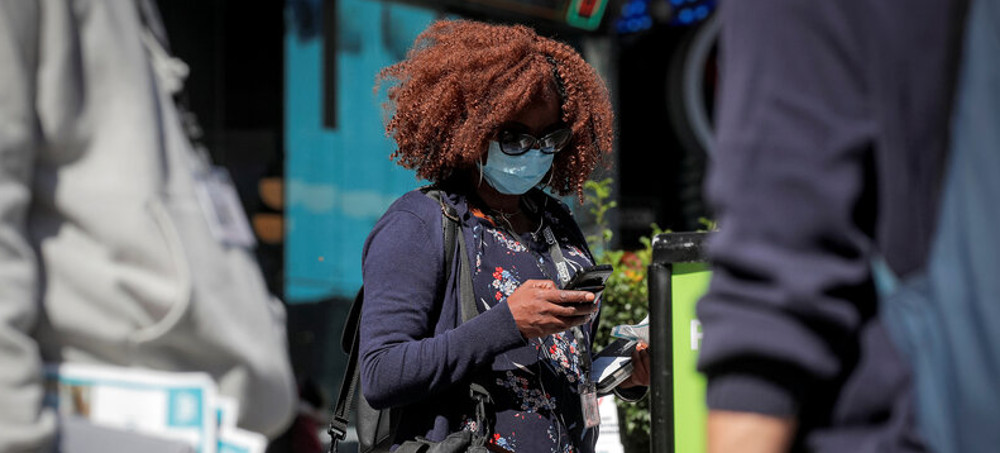 A Census Bureau worker waits to gather information from people during a 2020 census promotional event in New York City. (photo: Brendan McDemid/Reuters)
A Census Bureau worker waits to gather information from people during a 2020 census promotional event in New York City. (photo: Brendan McDemid/Reuters)
Latinos — with a net undercount rate of 4.99% — were left out of the 2020 census at more than three times the rate of a decade earlier.
Among Native Americans living on reservations (5.64%) and Black people (3.30%), the net undercount rates were numerically higher but not statistically different from the 2010 rates.
People who identified as white and not Latino were overcounted at a net rate of 1.64%, almost double the rate in 2010. Asian Americans were also overcounted (2.62%). The bureau said based on its estimates, it's unclear how well the 2020 tally counted Pacific Islanders.
The long-awaited findings came from a follow-up survey the bureau conducted to measure the accuracy of the latest head count of people living in the U.S., which is used to redistribute political representation and federal funding across the country for the next 10 years.
Other estimates the bureau released on Thursday revealed that the most recent census followed another long-running trend of undercounting young children under age 5.
COVID and Trump administration meddling hurt the count's accuracy
While the bureau's stated goal is to "count everyone once, only once, and in the right place," miscounts have come with every census. Some people are counted more than once at different addresses, driving overcounts, while U.S. residents missing from the census fuel undercounting.
Disruptions from the coronavirus pandemic and interference by former President Donald Trump's administration raised alarms about the increased risk of the once-a-decade tally missing swaths of the country's population. COVID-19 also caused multiple delays to the bureau's Post-Enumeration Survey that's used to determine how accurate the census results are and inform planning for the next national count in 2030.
During the news conference announcing the follow-up survey results, Census Bureau Director Robert Santos — who, before becoming the agency's head, told Bloomberg CityLab that he believed the census was "being sabotaged" during the Trump administration to produce results that benefit Republicans — acknowledged "an unprecedented set of challenges" facing the bureau over the last couple of years.
"Many of you, including myself, voiced concerns. How could anyone not be concerned? These findings will put some of those concerns to rest and leave others for further exploration," Santos, a Biden administration appointee, said during the news conference announcing the follow-up survey results.
The bureau said previously that it believes the census results are "fit to use" for reallocating each state's share of congressional seats and Electoral College votes, as well as redrawing voting districts.
Census numbers are also used to guide the distribution of an estimated $1.5 trillion each year in federal money to communities for health care, education, transportation and other public services. Some tribal, state and local officials are considering ways of challenging the results for potential corrections that would be factored into future funding decisions.
The report the bureau released on Thursday only provided a national-level look at the count's accuracy, and the agency says it's planning to release state-level metrics this summer.
"There are a lot more states for us to check and review and look through," said Timothy Kennel, assistant division chief for statistical methods, during a webinar before Thursday's release.
Civil rights groups are looking for remedies
Still, these national-level metrics resurfaced concerns among civil rights organizations and other census watchers who have warned for years about the risk of racial gaps in the census numbers leading to inequitable allocations of political power and federal money.
In response to the bureau reporting that American Indians and Alaska Natives living on reservations continued to have the highest net undercount rate among racial and ethnic groups, Fawn Sharp, president of the National Congress of American Indians, said the results "confirm our worst fears."
"Every undercounted household and individual in our communities means lost funding and resources that are desperately needed to address the significant disparities we face," added Sharp, who is also the vice president of the Quinault Indian Nation in Taholah, Wash., in a statement.
Marc Morial, the president and CEO of the National Urban League, which led a federal lawsuit in 2020 to try to stop Trump officials from cutting counting efforts short, said the group's lawyers are considering returning to court to try to secure a remedy.
"We've talked about voter suppression. Now we see population suppression," Morial said on a call with reporters. "And when you tie them together, it is the poisonous tree of seeking to diminish the distribution of power in this nation on a fair and equitable basis."
Other longtime census watchers see this moment as a chance to reimagine what the next count in 2030 could look like.
Arturo Vargas, CEO of the National Association of Latino Elected and Appointed Officials Educational Fund, said the next census should be taken in a "much more modern and effective way" to address the persistent undercounting of Latinos and other people of color.
"This whole notion of coming up with a master address file and mailing everybody an invitation to participate and hoping that they respond, and if they don't, you go knock on their doors, that's an obsolete way now of counting the U.S. population. We need a better way. I don't have the answer to what that better way is, but I want to work with the Census Bureau to figure it out," Vargas added.
In addition to looking ahead to the next decade, Vargas noted a more immediate concern: how to improve the annual population estimates that the bureau produces using 2020 census data and that states and local communities rely on to get their shares of federal funding.
Asked by NPR if there are any plans to factor the new over and undercounting rates into those estimates, Karen Battle, chief of the bureau's population division, replied the agency is "taking steps in that direction."
"But we have to do research so that we can understand whether or not we can do that," Battle said.
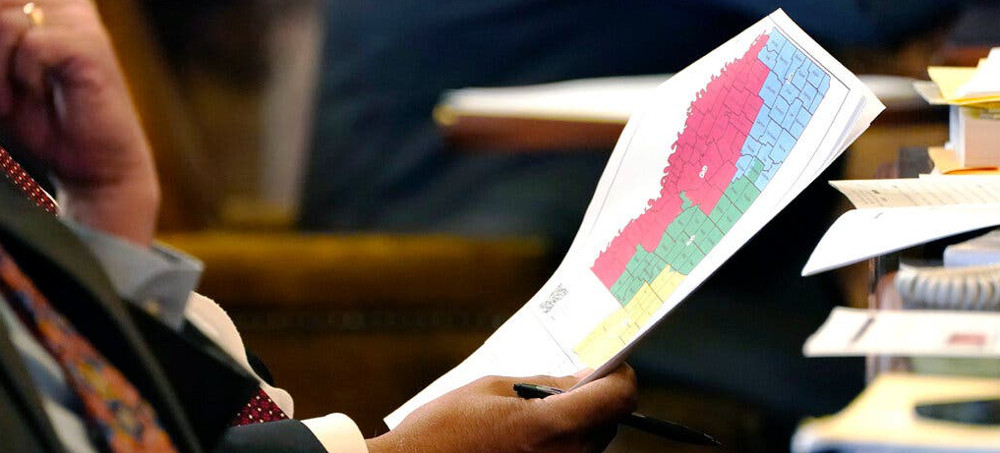 In Mississippi, State Senator Joseph Thomas, a Democrat, held a copy of a proposed congressional map in January. (photo: Rogelio V. Solis/AP)
In Mississippi, State Senator Joseph Thomas, a Democrat, held a copy of a proposed congressional map in January. (photo: Rogelio V. Solis/AP)
This year’s congressional map, despite continued gerrymandering, is poised to have a nearly equal number of districts that lean Democratic and Republican.
But that may not remain the case for long.
In a departure from a decades-long pattern in American politics, this year’s national congressional map is poised to be balanced between the two parties, with a nearly equal number of districts that are expected to lean Democratic and Republican for the first time in more than 50 years.
Despite the persistence of partisan gerrymandering, between 216 and 219 congressional districts, out of the 435 nationwide, appear likely to tilt toward the Democrats, according to a New York Times analysis based on recent presidential election results. An identical 216 to 219 districts appear likely to tilt toward Republicans, if the maps enacted so far withstand legal challenges. To reach a majority, a party needs to secure 218 districts.
The surprisingly fair map defies the expectations of many analysts, who had believed that the Republicans would use the redistricting process to build an overwhelming structural advantage in the House, as they did a decade ago.
 The final obstacle to mining in Thacker Pass in Nevada is a federal lawsuit. (photo: Carolyn Cole/LA Times)
The final obstacle to mining in Thacker Pass in Nevada is a federal lawsuit. (photo: Carolyn Cole/LA Times)
The final obstacle to mining in Thacker Pass is a federal lawsuit
The final obstacle to the mine remains a federal lawsuit filed by a coalition of nearby Indigenous communities, environmental groups, and a local rancher. The suit alleges that when the Bureau of Land Management, or BLM, approved the project in January of 2021, the approval was based on a flawed environmental review and was rushed through without adequate consultation of tribes, as required by law.
According to Lithium Americas Corporation, the company behind the mine, a decision on the lawsuit is expected in September 2022.
The soft clay in the ground below Thacker Pass, located about 50 miles south of the Nevada-Oregon border, is rich in lithium. Lithium Americas Corporation says it can generate up to 60,000 metric tons of battery-grade lithium from the mine each year. That’s nearly two times the amount of lithium the U.S. used in 2020, but only 20% of projected demand by 2030.
Lithium-ion batteries are a key component of the U.S.’s plan to decarbonize, since they power electric vehicles and are increasingly being used to store energy generated by wind and solar. Soon after taking office, President Biden issued an executive order focused on making supply chains, including the battery supply chain, more resilient. In early February, the Department of Energy announced it would make $2.9 billion available to fund projects that bolster domestic battery manufacturing and recycling.
Development of the Thacker Pass mine has been contentious. On January 15, 2021, the BLM approved the project. A few weeks later, local cattle rancher Edward Bartell sued the federal government, alleging that the environmental impact statement BLM relied upon was “one sided, deeply flawed, and incomplete,” and underestimated the effects on groundwater and streams. Bartell was soon joined by several conservation groups, who argued that BLM had ignored a wide range of environmental impacts, including groundwater contamination and harm to the greater sage-grouse, in a rush to approve the project.
Several tribes and Native American organizations also oppose the Thacker Pass mine. During the summer of 2021, a group called the People of the Red Mountain, the Burns Paiute Tribe, and the Reno-Sparks Indian Colony intervened in the lawsuit filed by Bartell and the conservation groups. The coalition alleges that BLM violated the National Historic Preservation Act by failing to adequately consult them. They note that in 1865, the 1st Nevada Cavalry Battalion massacred dozens of Paiute men, women, and children at a camp in the Thacker Pass area, and say that the mine would destroy land they believe is a mass grave.
On February 25, the Nevada Division of Environmental Protection granted water pollution control, air pollution control, and mine reclamation permits for the Thacker Pass mine. Kelly Fuller, energy and mining campaign director for the Western Watersheds Project, one of the environmental groups involved in the lawsuit, told E…E News that the state permits “do not mean that the fight against the mine is over.”
Follow us on facebook and twitter!
PO Box 2043 / Citrus Heights, CA 95611

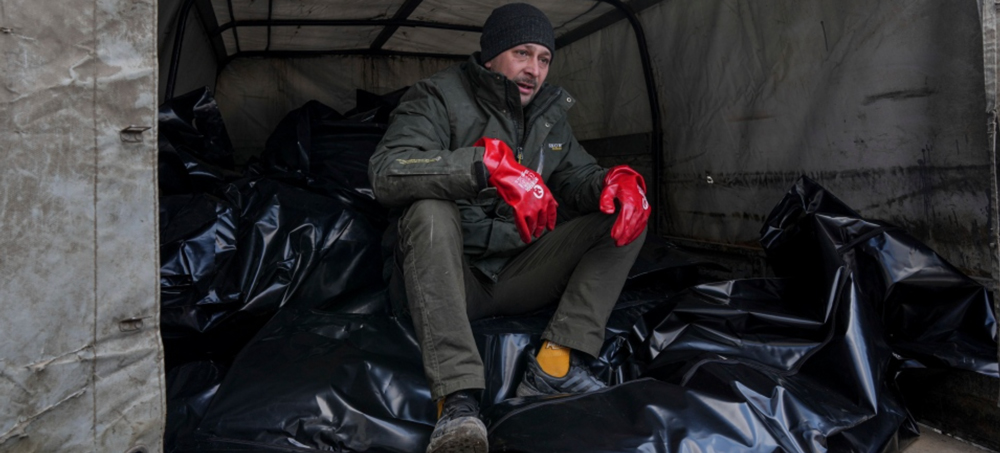
No comments:
Post a Comment
Note: Only a member of this blog may post a comment.